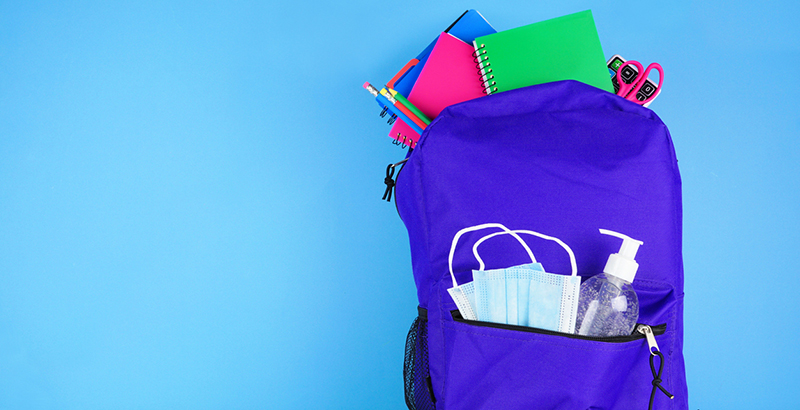COVID Brief: Teachers’ and Teens’ Mental Health Took a Hit During COVID
A weekly roundup of headlines about how the pandemic is shaping schools and education policy, vetted by AEI Visiting Fellow John Bailey

Get stories like this delivered straight to your inbox. Sign up for The 74 Newsletter
This Week’s Top Story
Mental Health of Teachers, Teens Takes Big COVID-19 Hit
- Via CIDRAP
- “Teachers were at 40% higher risk of reporting anxiety within the previous seven days than were health care workers, 20% more likely than office workers and 30% more likely than workers in other occupations, such as military, farming and legal professions.
- “Teachers with a remote role were 60% more likely to report feeling isolated than their in-person counterparts, and female teachers had 70% higher odds of anxiety than their male peers.”
- “In the study on pandemic teen mental health, researchers from Children’s Hospital of Philadelphia (CHOP) mined data on 9,720 U.S. adolescents who responded to at least one survey fielded by the Adolescent Brain Cognitive Development Study, a sample of more than 10,000 U.S. children 11 to 14 years old, from May 2020 to May 2021.”
- “Over 70% of adolescents said their families lost wages during the pandemic. Teens in families that sustained lost income were more likely to be Black (19.5% vs. 12.2%), Hispanic (22% vs. 12.9%), and living below the poverty line (15.2% vs. 4.2%) than those without financial losses. These populations also reported higher levels of stress about the financial toll.”
- Related: Teachers felt more COVID anxiety than health care workers, study finds (The 74)

The Big Three
‘The Bottom Has Dropped Out’: Study Confirms Fears of Growing Learning Gaps
- The 74 on a new NWEA report
- “Before the pandemic, the average fifth-grade class had students whose learning spanned seven grade levels. But in May 2020, NWEA, the nonprofit behind the widely used MAP Growth assessment, predicted that this variation would grow as the lowest-scoring students would fall two years behind. Because the exams are not given before third grade, the researchers warned then that their findings might not reflect students whose levels of understanding are even lower.”
- “New NWEA research finds this range has increased by 5% to 10%, with the losses disproportionately affecting low-performing students. While all pupils made less progress than they would have without COVID-19’s interruptions to instruction, children who were already struggling academically have fallen much further behind.”
- Chalkbeat: “Students who were already struggling were hit harder by the initial COVID disruptions and are now rebounding at a slower rate than their highest-achieving peers, according to findings from testing group NWEA.”
- “ ‘The ceiling stayed pretty consistent to where it was before, but the floor has dropped substantially, and I worry that we’re starting to push teachers beyond their capacity to meet that diversity of needs,’ said Karyn Lewis, an NWEA researcher. ‘So I think this has less implications for what teachers should be doing, but more for what we should be doing as supporters of teachers.’ “
$20 Billion of ESSER Funds at Risk of Not Being Spent
- Important new report from McKinsey
- A survey of district leaders found that more than 90% have faced challenges deploying stimulus funds effectively.
- “By the end of the 2021-22 school year — halfway through the available funding window — districts had spent an estimated $45 billion of total available funds. That leaves $140 billion to allocate over the next three budget cycles, increasing districts’ near-term annual budgets by approximately 5% to 6%.”
- “Based on these findings, McKinsey projects that nearly $20 billion in ESSER funds may not be obligated by the deadline because of a variety of factors, including administrative hurdles, limited internal planning capacity, and talent and vendor shortages.”
- “Nearly three-quarters of district administrators said they had struggled to overcome administrative hurdles to receiving funds, navigating compliance and finalizing procurement.”
More than Half of Schools Offering After-School Academic Programs
- New school survey data via National Center for Education Statistics
- “56% of public schools are offering afterschool programs for students who need academic assistance during the 2022-23 school year.”
- “48% of public schools offering this type of programming incorporate high-dosage tutoring into the programming, while 42% incorporate some other type of tutoring.”
- “As of September 2022, 85% of public schools had no COVID-19 vaccination requirements for staff to be in the school building for the 2022-23 school year.”
- “99% percent of public schools had no COVID-19 vaccination requirements for students to be in the school building for the 2022-23 school year.”
- “12% of public schools required that students wear masks inside the school building in September 2022, compared to 15% at the end of the 2021-22 school year.”
- “The percentage of public schools that reported having to quarantine students in September was 47%, an increase from the 34% that required students to quarantine at the end of the 2021-22 school year.”
Federal Updates
White House: Will seek $10 billion in COVID funding in the lame-duck session
Senate: Votes to end COVID-19 Emergency Declaration
- “The Senate voted 62-36 to end the emergency declaration nearly three years after it was invoked. It’s unclear if the House will take up the measure.”
- “President Biden threatened to veto any congressional efforts to end the national emergency declaration’s status, said the Office of Management and Budget” in a statement.
Federal Communications Commission: Establishes grant programs to raise awareness of the Affordable Connectivity Program
City & State News
California: Report: State likely to have $25 billion budget deficit
Iowa: Gov. Kim Reynolds will appeal a federal court ruling that enables school districts to impose universal mask mandates on students and staff
Nebraska: Nebraska invests in K-8 math acceleration [with Zearn] and analyzes impact
New Hampshire: How schools and state officials are using $500 million in COVID relief money
New Jersey: Gov. Phil Murphy issues order to create task force to address teacher shortage
COVID-19 Research
Study Suggests In-Person Learning Was an ‘Equalizer’ During COVID
- New study with North Carolina data: “Our findings support the notion that in-person schooling during the pandemic may serve as an equalizer for lower-achieving students, particularly from historically marginalized or vulnerable student populations.”
- “A study led by a North Carolina State University researcher found that although there were steep learning losses in reading for elementary school students during the COVID-19 pandemic, in-person learning opportunities helped some of those students mitigate learning loss and accelerate gains in reading compared to online learners.”
- “Younger elementary students from lower socioeconomic backgrounds, English learners and students with disabilities were particularly affected by the pandemic school closures.”
22% of Kids With COVID-19 or MIS-C Had a Neurologic Condition
- Via CIDRAP: “A study of U.S. patients aged 0 to 20 years hospitalized for COVID-19 or multisystem inflammatory syndrome in children (MIS-C) in 2020 and 2021 shows that 22% had a neurologic condition, including 9% with life-threatening illness.”
- “Life-threatening neurologic disorders were more common during the Delta variant surge than in previous waves (64% vs. 36%). Ten of 42 (24%) of patients with neurologic involvement were released from the hospital with new-onset neurologic conditions, and 8 (19%) died. Among patients with non–life-threatening neurologic involvement, 4% were released from the hospital with neurologic deficits, 90% had no neurologic disorders and 5% died.”
- “COVID-19 vaccination is effective at preventing hospitalization for acute COVID-19 and MIS-C and may decrease associated neurologic complications.”
More noteworthy research:
The COVID-19 School Data Hub launched new visual updates to the website that allow users to explore each state’s learning model and assessment data.
COVID-19 Surges Linked to Spike in Heart Attacks (Study)
COVID-19 and Diabetes — Where Are We Now? (A look at the research from Nature)
Political Ideology of U.S. Elected Officials Linked With COVID-19 Health Outcomes (Study from Harvard T.H. Chan School of Public Health)
Virtual School Enrollment Kept Climbing Even as COVID Receded (Center on Reinventing Public Education via The 74)
Viewpoints

Closing Schools in the Pandemic Was Bad. Keeping Them All Open Would Have Been Worse
- Michael Hiltzi in the L.A. Times
- “The consequences of extended school closures were brought home, vividly, with the release late last month of reading and math scores for fourth- and eighth-graders, documenting a sharp slide in proficiency since the pre-pandemic year of 2019.”
- “Yet there’s much more to consider. The question that never gets raised, much less answered, when the conversation turns to how bad the school closures were, is: ‘Compared to what?’ ”
- “The number of deaths among children younger than 18, which the Centers for Disease Control and Prevention pegs at 1,853, ‘would have been higher had 60-70 million unvaccinated children contracted the virus over several months’ time in 2020. It’s reasonable to assume that several thousand children would have died.’ ”
- “Those findings might explain what happened when Florida opened its schools in August 2021 and banned remote teaching: Child COVID deaths in the state more than doubled by the first week of September. One month into the reopenings, districts across the state were being forced to shut down schools and impose quarantines affecting thousands of pupils.”
- “More than 1 in 5 children hospitalized with acute COVID infections suffered lasting neurological conditions, according to a 2021 study. Thousands may have suffered severe neurological conditions, even including stroke.”
Lifting Universal Masking in Schools — COVID-19 Incidence Among Students and Staff
- New England Journal of Medicine study
- “Before the statewide masking policy was rescinded, trends in the incidence of COVID-19 were similar across school districts.”
- “During the 15 weeks after the statewide masking policy was rescinded, the lifting of masking requirements was associated with an additional 44.9 cases per 1,000 students and staff (95% confidence interval, 32.6 to 57.1), which corresponded to an estimated 11,901 cases and to 29.4% of the cases in all districts during that time.”
- “Our results support universal masking as an important strategy for reducing COVID-19 incidence in schools and loss of in-person school days. As such, we believe that universal masking may be especially useful for mitigating effects of structural racism in schools, including potential deepening of educational inequities.”
- But: NEJM’s Disappointing Decision to Publish the Boston School Mask Study: Via Tracy Beth Høeg
…And on a Lighter Note
When Your Friend: Unexpectedly shows up
This is our weekly briefing on the pandemic, vetted by John Bailey. See the full archive.
For even more COVID policy and education news, subscribe to John Bailey’s daily briefing via Substack.
Disclosure: John Bailey is an adviser to the Walton Family Foundation, which provides financial support to The 74.
Get stories like these delivered straight to your inbox. Sign up for The 74 Newsletter

;)
